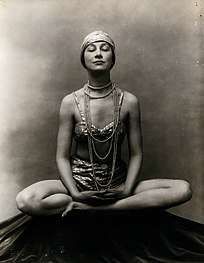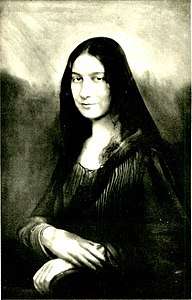Marguerite Agniel
Marguerite Agniel (21 January 1891–April 1971) was a Broadway actress and dancer, and then a health and beauty guru[1] in New York in the early 20th century. She is known for her 1931 book The Art of the Body: Rhythmic Exercise for Health and Beauty, one of the first to combine yoga and nudism.[2]
Marguerite Agniel | |
|---|---|
 In Halasana, Plough Pose. Photograph by John de Mirjian, c. 1928 | |
| Born | January 21, 1891 |
| Died | |
| Nationality | American |
| Known for | actress, dancer, health and beauty guru |
Early life
The Agniel family was French Jewish; her mother's family (Flowers) was English.[3]
Broadway career
Agniel performed in Broadway plays including The Amber Empress with music by Zoel Parenteau in 1916, and Raymond Hitchcock's Pin Wheel in 1922.[4][5]
Author
She appeared in the 15 November 1926 issue of Vogue, demonstrating slimming exercises in the form of floor stretches, with postures close to the yoga asanas Salabhasana, Supta Virasana, Sarvangasana and Halasana.[6] She wrote for Physical Culture magazine in 1927 and 1928.[7]
In 1931 Agniel wrote the book The Art of the Body : Rhythmic Exercise for Health and Beauty, illustrated mainly with photographs of herself; she notes in the Preface that her dance technique derives from Ruth St. Denis (who in turn followed François Delsarte), but that her "system of 'aesthetic athletics'"[8] was based mainly on that of Bernarr Macfadden, an advocate of physical culture. She names the sexologist Havelock Ellis and the musicologist Sigmund Spaeth as major influences, stating that both had shown "an extraordinarily intuitive understanding"[8] of her work.[8][9]
Agniel wrote a piece called "The Mental Element in Our Physical Well-Being" for The Nudist, an American magazine, in 1938; it showed nude women practising yoga, accompanied by a text on attention to the breath. The social historian Sarah Schrank comments that it made perfect sense at this stage of the development of yoga in America to combine nudism and yoga, as "both were exercises in healthful living; both were countercultural and bohemian; both highlighted the body; and both were sensual without being explicitly erotic."[2][10]

 In Supta Virasana, demonstrating "A good exercise for the back and abdominal muscles". Photograph by John de Mirjian, c. 1928
In Supta Virasana, demonstrating "A good exercise for the back and abdominal muscles". Photograph by John de Mirjian, c. 1928
Reception

Her friend Havelock Ellis wrote in a letter to Louise Stevens Bryant (17 May 1936) that Agniel's books were "full of beautiful illustrations, nearly all of herself. She has a wonderful art of posing, & they are largely nudes, though she is no longer young."[3]
Agniel is depicted in an "elegant, though sharply ironic"[11] Palladium photographic print by Margaret Watkins, "Head and Hand". It shows her hand holding a portrait sculpture head of herself by Jo Davidson.[11] This was one in a series of portraits of Agniel by Watkins that Agniel used in The Art of the Body. Devon Smither describes Agniel as "a leading health and beauty guru",[1] and the Art of the Body as "a moralizing exercise manual" providing a mixture of exercises, advice on cosmetics, and spiritual guidance.[1]
Mary O'Connor and Katherine Tweedie comment on Watkins's portraits of Agniel that they were circulated sometimes as artistic "nudes", sometimes as portraits, and sometimes as instances of "a regime of exercise and body modification".[12] They write that since Agniel chose to use these photographs of herself, she is presenting them "not as the passive victim of an objectifying male gaze .. but as the means of promulgating her own vision of the world and her own expertise. She circulates her body as an image of the ideal and for commercial profit."[12]
Works
- 1931 The Art of the Body. London: Batsford.
- 1933 Body Sculpture. New York: E.H. & A.C. Friedrichs.
- 1936 Your Figure. Garden City, N.Y.: Doubleday, Doran & Company.
See also
References
- Smither, Devon (2019). "Defying convention: The female nude in Canadian painting and photography during the interwar period". Journal of Historical Sociology. 32 (1): 77–93. doi:10.1111/johs.12219. ISSN 0952-1909.
- Schrank, Sarah (2016). Berila, Beth; Klein, Melanie; Roberts, Chelsea Jackson (eds.). Naked Yoga and the Sexualization of Asana. Yoga, the Body, and Embodied Social Change: An Intersectional Feminist Analysis. Lexington Books. pp. 155–174. ISBN 978-1-4985-2803-0.
- Ellis, Havelock. "Letters to an American". VQR (Spring 1940).
- "Marguerite Agniel". Internet Broadway Database. Retrieved 5 November 2019.
- "Zoel Parenteau, Stage Composer". The New York Times. 15 September 1972. p. 40.
- Peters, Lauren Downing (31 May 2018). Stoutwear and the Discourses of Disorder: Constructing the Fat, Female Body in American Fashion in the Age of Standardization, 1915-1930 (PDF). Stockholm University (D. Phil. Thesis). pp. 305, 307.
- "au:Marguerite Agniel". WorldCat. Retrieved 5 November 2019.
- Agniel, Marguerite (1931). The Art of the Body : Rhythmic Exercise for Health and Beauty. London: B. T. Batsford. p. ix. OCLC 1069247718.
- Routledge, Isobel (28 November 2014). "Meditation and modernity: an image of Marguerite Agniel". Wellcome Library.
- Schrank, Sarah (2019). Free and natural : nudity and the American cult of the body. Philadelphia: University of Pennsylvania Press. pp. 176–177. ISBN 978-0-8122-5142-5. OCLC 1056781478.
- "Modern Scottish Women / Painters and Sculptors 1885-1965". Georgina Coburn Arts. 27 January 2016.
- O'Connor, Mary; Tweedie, Katherine (2007). Seduced by Modernity: The Photography of Margaret Watkins. McGill-Queen's University Press. pp. 91–92. ISBN 978-0-7735-7566-0.
